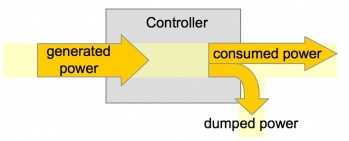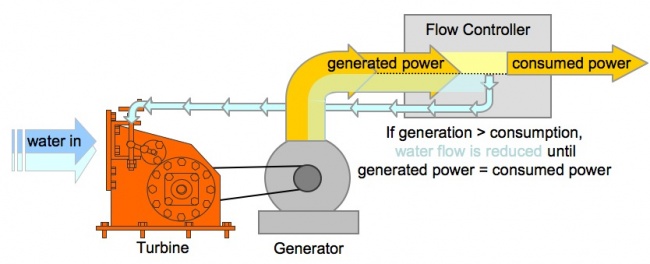Difference between revisions of "Electrical-Mechanical Equipment"
***** (***** | *****) |
***** (***** | *****) |
||
| Line 17: | Line 17: | ||
Small hydropower plants usually use (part-) river flow as driving force. Storage basins or even dams can buffer water. So demand peaks or (short) periods of water shortage can be bridged. As such infrastructures is costly and sophisticated, it's only used if there is a clear financial revenue; e.g. electricity supply for remote industries. | Small hydropower plants usually use (part-) river flow as driving force. Storage basins or even dams can buffer water. So demand peaks or (short) periods of water shortage can be bridged. As such infrastructures is costly and sophisticated, it's only used if there is a clear financial revenue; e.g. electricity supply for remote industries. | ||
| − | == | + | == Ballast or dump load == |
| − | + | <!--{12766841534926}--><span>A ballast load is mostly an electrical resistance heater. It's sized to handle the | |
| + | </span>full generating capacity of the microhydro turbine. They're placed in air or water. If there is more electricity produced then consumed the charge controller uses this excess energy to generate heat.<br> | ||
| − | + | Other but not common ballast load may be pumping water or ice production. | |
| − | |||
| − | |||
| − | load | ||
| − | |||
== '''Metering''' == | == '''Metering''' == | ||
Revision as of 11:19, 16 June 2010
Introduction
disambiguation:
grid connection
island / isolated grids
battery storage / charging stations
Grid connection for mhp's
Hydropower usually operates 24 h / day. Most mhp's are connected by a grid to their consumers. If a connection towards the national or main grid is available, electricity can be fed in there. Often micro or pico hydropower units are installed in remote areas. There they feed an isolated grid. In such grid the mhp is usually the only power source. The power produced has to be leveled equal with the power consumed (see controller).
Battery storage is no must like at solar or wind power projects. This is a big advantage as it reduces costs and maintenance significantly. Nevertheless can charging stations extend a mhp's effectiveness by utilising power in times of low demand (late night). So even consumers can be served with are to far from the station to be connected by transmission cable.
Storage basin or dams
Small hydropower plants usually use (part-) river flow as driving force. Storage basins or even dams can buffer water. So demand peaks or (short) periods of water shortage can be bridged. As such infrastructures is costly and sophisticated, it's only used if there is a clear financial revenue; e.g. electricity supply for remote industries.
Ballast or dump load
A ballast load is mostly an electrical resistance heater. It's sized to handle the
full generating capacity of the microhydro turbine. They're placed in air or water. If there is more electricity produced then consumed the charge controller uses this excess energy to generate heat.
Other but not common ballast load may be pumping water or ice production.
Metering
AKA: battery monitor, amp-hour meter, watt-hour meter
[[Image:|Metering]]
System meters measure and display several different aspects of your microhydro-electric system´s performance and status—tracking how full your battery bank is, how much electricity your turbine is producing or has produced, and how much electricity is being used. Operating your system without metering is like running your car without any gauges—although possible to do, it´s always better to know how well the car is operating and how much fuel is in the tank.
[[|]]Main DC Disconnect
AKA: Battery/Inverter disconnect
[[Image:|Main DC Disconnect]]
In
battery-based systems, a disconnect between the batteries and inverter
is
required. This disconnect is typically a large, DC-rated breaker mounted
in a sheet-metal enclosure. It allows the inverter to be disconnected from the batteries for service, and protects the inverter-to-battery wiring against electrical faults.
Inverter
AKA: DC-to-AC converter
[[Image:|Battery-Based Inverter]]Inverters transform
the DC electricity stored in your battery bank into AC electricity
for powering household appliances. Grid-tied inverters synchronize the system´s output with the utility´s AC electricity, allowing the system to feed hydro-electricity to the utility grid. Battery-based inverters for off-grid or grid-tied systems often include a battery charger, which is capable of charging a battery bank from either the grid or a backup generator if your creek isn´t flowing or your system is down for maintenance.
In rare cases, an inverter and battery bank are used with larger, off-grid AC-direct systems to increase power availability. The inverter uses the AC to charge the batteries, and synchronizes with the hydro-electric AC supply to supplement it when demand is greater than the output of the hydro generator.
[[|]]AC Breaker Panel
AKA: mains panel, breaker box, service entrance
[[Image:|AC Breaker Panel]]
The AC
breaker panel, or mains panel, is the point at which all of a home´s
electrical
wiring meets with the provider of the electricity, whether that´s the
grid or a
microhydro-electric system. This wall-mounted panel or box is usually
installed
in a utility room, basement, garage, or on the exterior of a building.
It
contains a number of labeled circuit breakers that route electricity to
the various
rooms throughout a house. These breakers allow electricity to be
disconnected
for servicing, and also protect the building´s wiring against electrical firess.
Just like the electrical circuits in your home or office, a grid-tied inverter´s electrical output needs to be routed through an AC circuit breaker. This breaker is usually mounted inside the building´s mains panel. It enables the inverter to be disconnected from either the grid or from electrical loads if servicing is necessary. The breaker also safeguards the circuit´s electrical wiring.
Kilowatt-Hour Meter
AKA: KWH meter, utility meter
[[Image:|Kilowatt-Hour Meter]]
Most
homes with grid-tied microhydro-electric systems will have AC
electricity both
coming from and going to the utility grid. A multichannel KWH meter
keeps track
of how much grid electricity you´re using and how much your RE system is
producing. The utility company often provides intertie-capable meters at no costs
'Turbines'types
[[Image:]]
A turbine converts the energy in falling water into shaft power. There are various types of turbine which
can be
categorised in one of several ways. The choice of turbine will depend mainly on the pressure head available and the design flow for the proposed hydropower installation. As shown in table 2 below, turbines are broadly divided into three groups; high, medium and low head, and into two categories: impulse and reaction.
Turbine Runner |
Head pressure | ||
|
High |
Medium |
Low | |
|
Impulse |
Pelton Turgo Multi-jet Pelton |
Crossflow Turgo Multi-jet Pelton |
Crossflow |
|
Reaction |
Francis Pump-as-turbine (PAT) |
Propeller Kaplan |
|
The difference between impulse and reaction can be explained simply by stating that the impulse turbines convert the kinetic energy of a jet of water in air into movement by striking turbine buckets or blades - there is no pressure reduction as the water pressure is atmospheric on both sides of the impeller. The blades of a reaction turbine, on the other hand, are totally immersed in the flow of water, and the angular as well as linear momentum of the water is converted into shaft power - the pressure of water leaving the runner is reduced to atmospheric or lower.
Load factor
The load factor is the amount of power used divided by the amount of power that is available if the turbine were to be used continuously. Unlike technologies relying on costly fuel sources, the 'fuel' for hydropower generation is free and therefore the plant becomes more cost effective if run for a high percentage of the time. If the turbine is only used for domestic lighting in the evenings then the plant factor will be very low. If the turbine provides power for rural industry during the day, meets domestic demand during the evening, and maybe pumps water for irrigation in the evening, then the plant factor will be high.
It is very important to ensure a high plant factor if the scheme is to be cost effective and this should be taken into account during the planning stage. Many schemes use a 'dump' load (in conjunction with an electronic load controller - see below), which is effectively a low priority energy demand that can accept surplus energy when an excess is produced e.g. water heating, storage heaters or storage cookers.
Load control governors
Water turbines, like petrol or diesel engines, will vary in speed as load is applied or relieved. Although not such a great problem with machinery which uses direct shaft power, this speed variation will seriously affect both frequency and voltage output from a generator. Traditionally, complex hydraulic or mechanical speed governors altered flow as the load varied, but more recently an electronic load controller (ELC) has been developed which has increased the simplicity and reliability of modern micro-hydro sets. The ELC prevents speed variations by continuously adding or subtracting an artificial load, so that in effect, the turbine is working permanently under full load. A further benefit is that the ELC has no moving parts, is very reliable and virtually maintenance free. The advent of electronic load control has allowed the introduction of simple and efficient, multi-jet turbines, no longer burdened by expensive hydraulic governors.
Controller:
Function
principles
Load- or Flow- controller ensure that the power output does not exceed the power demand (e.g. 230V, 50 Hz).
If flow of water in a MHP-station is constant the energy output of a turbine/generator is constant as well. Power demand is usually fluctuating over the time (e.g. day/night). If supply is higher than demand, excess energy must be diverted, dumped. alternatively the water flow can be reduced which results in less power output.
In case of more power demand than supply the controller cuts of the of demand line.
Load controller are placed between generator output and the consumer line.
Controller Types
Load controller:
Electronic circuit, which keeps output power constant in Frequency- and Voltage- parameters.
Fluctuating energy demand requires a mechanism which either regulates the water input into the turbine (= flow control) or by diverting excess energy from the consumer connection (= ballast load).
Ballast load
usually electrical heaters in water or air. If energy demand is temporarily low the excess energy is converted into heat.
Flow control
regulates the amount of water into the turbine in order to match power output and power demand.
Nowadays flow control is done mostly via electronics (which steer a valve)






















